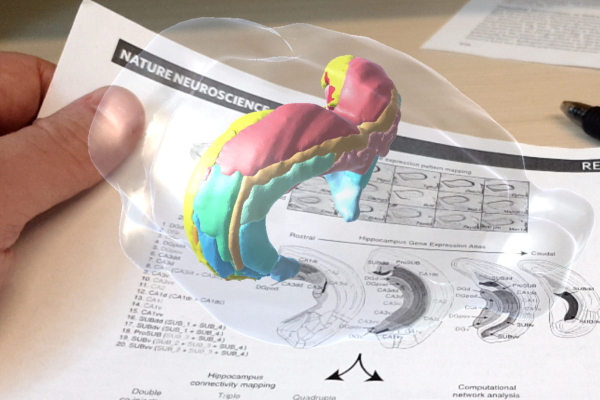[A new app created at the University of Southern California augments 2D printed graphics with interactive 3D images to provide users a presence experience that more effectively communicates scientific data. This story from USC News is followed by an excerpt from subsequent coverage in USC’s Annenberg Media. A 1:33 minute demonstration video is available via YouTube and you can download the app (and soon the companion app for creators) here. –Matthew]

[Image: Credit: Courtesy of Tyler Ard and Arthur Toga]
Augmented reality app adds interactive enhancements to scientific posters, presentations
A new smartphone app created by USC scientists uses augmented reality to visualize scientific data via 3D models and video.
By Zara Greenbaum
October 17, 2019
USC scientists have launched a smartphone application that uses augmented reality to add 3D models, fly-throughs and other data to enrich science communication materials such as posters, publications and presentation materials.
The app’s creator, Tyler Ard, assistant professor of research at the USC Mark and Mary Stevens Neuroimaging and Informatics Institute of the Keck School of Medicine of USC, used software similar to that used by Pokémon Go. Users of the augmented reality app simply point their smartphone cameras at a supported image to pull up hidden interactive content.
“Our goal is to facilitate the exchange of ideas and information in a way that’s less prone to misinterpretation, and more conducive to conveying the deep comprehension that underlies the scientific process,” Ard said. The app, named Schol-AR, will soon allow researchers at USC and beyond to upload their own materials.
Augmented reality app provides visual insight into human biology
Schol-AR debuted this month on the cover of the journal NeuroImage, which features a study by Danny Wang, professor of neurology and director of imaging technology innovation at the USC Stevens Neuroimaging and Informatics Institute. The cover image, based on high-resolution data collected by the institute’s ultra-high-field 7Telsa magnetic resonance imaging scanner, depicts very small blood vessels in the brain known as lenticulostriate arteries. Wang and his team have developed and tested a new noninvasive method for precisely visualizing these vessels, which can help in the study and treatment of cerebral small vessel disease.
But view this image through the Schol-AR app and suddenly you see the size, shape and positioning of these vessels as they relate to the brain structures they supply. When users can manually enlarge, rotate and explore, a much more realistic picture of the underlying biology emerges.
“The 3D model provides more insight into where these arteries are situated within the context of important structures in the brain,” said Samantha Ma, graduate student researcher at the USC Stevens Neuroimaging and Informatics Institute, first author on the study and a member of Wang’s team. “Interacting with the augmented version allows readers to understand how the shape of these vessels could change with age, disease or both.”
Schol-AR debuts today at the annual meeting of the Society for Neuroscience in Chicago. The USC Stevens Neuroimaging and Informatics Institute will also release Schol-AR Creator, a companion application that allows researchers everywhere to upload and embed interactive figures within their own educational materials.
“From its inception, we’ve opted to democratize this technology to aid the efforts of researchers across scientific disciplines,” said Arthur Toga, director of the USC Stevens Neuroimaging and Informatics Institute. “We envision that this groundbreaking new way of visualizing scientific data will change the way findings are communicated well beyond the field of neuroscience.”
—
[From USC’s Annenberg Media]
Augmented reality app helps scientific communication among scholars
October 29, 2019
By Beatrice Gao
[…]
“All scientific communication is still done with 2D printable article formats,” Ard told Annenberg Media. “That’s actually pretty limiting as most scientific fields have fully embraced visual technologies using media communications.”
The goal of Schol-AR, Ard said, is to make scientific communication more effective and make data visualization more vivid.
“[Augmented reality] is really moving the limitations of what we’re able to communicate,” Ard said. “A lot of the times figures are not seen through publications, so this is a way to really get better representations of data and other forms of information into people’s hands.”
Schol-AR was first used on October 17th at the annual meeting of the Society for Neuroscience in Chicago where people gave much “encouraging feedback” about the app, according to Ards.
“This problem of being [constrained] in what we can communicate through the typical papers and posters has been a long present thing that happens to a lot of people,” Ard said. “So a lot of people were really excited to be able to finally get past that effectively through augmented reality.”
Ard said the app started with neuroscience augmentations, but it will be applicable to other fields of sciences from math to archaeology, such as 3D images of fossil structures and weather patterns.
“We’re trying to make it applicable to all sorts of data type[s and] trying to make it appealing to many different fields as we go along,” Ard said.
In addition to enriching the contents of Schol-AR, Ard said they would like to support other devices which are AR capable, such as magic leap, a virtual display device that can be applicable to augmented reality technology.
Arthur Toga, the director of the USC Stevens Neuroimaging and Informatics Institute, said he believes in the future, using augmented reality to generate 3D models will be a normal way of illustrating data sets.
“Science generates very complicated data sets, and we shouldn’t just reduce them to two-dimensional pictures on a piece of paper,” Toga said. “We should always be able to interact with all of the nuances, all of the richness of the data using electronic approach.”
Leave a Reply